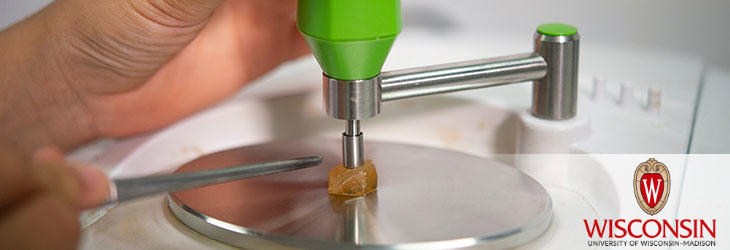Research Tools

Investigating Cell-Surface Interactions via Chemical Array
WARF: P120126US01
Inventors: William Murphy, Justin Koepsel
The Wisconsin Alumni Research Foundation (WARF) is seeking commercial partners to investigate the influences of surface-bound molecules on cell behavior using an alkanethiolate SAM array.
Overview
How and why precursor cells differentiate into tissue-specific cell types involves a complex interplay of signals and remains a rich topic of investigation. Outside of the body, for example, certain stem cells can develop into various mature forms like neural and endothelial cells when exposed to specific signaling factors during culture. These signals may be controlled by medium conditions as well as properties of the cell culture surface.
While extensive research has been devoted to understanding the influence of medium conditions on cell development, researchers have only recently begun to understand the role of culture surface properties. Self-assembled monolayer (SAM) substrates are a valuable tool in this process, enabling researchers to systematically expose cells to various surface-bound molecules — such as proteins, nucleic acids and polysaccharides — and analyze how these molecules influence cell behavior.
However, assay platforms using SAM technology have yet to become commonplace for cell biologists. Using traditional SAM approaches, a researcher hoping to perform an experiment using SAMs would need a background in organic chemistry and would be limited in throughput due to the labor intensive process required to produce multiple experimental conditions. Therefore, to make SAMs a realistic and practical tool for cell biologists, simplified and enhanced-throughput techniques need to be developed.
While extensive research has been devoted to understanding the influence of medium conditions on cell development, researchers have only recently begun to understand the role of culture surface properties. Self-assembled monolayer (SAM) substrates are a valuable tool in this process, enabling researchers to systematically expose cells to various surface-bound molecules — such as proteins, nucleic acids and polysaccharides — and analyze how these molecules influence cell behavior.
However, assay platforms using SAM technology have yet to become commonplace for cell biologists. Using traditional SAM approaches, a researcher hoping to perform an experiment using SAMs would need a background in organic chemistry and would be limited in throughput due to the labor intensive process required to produce multiple experimental conditions. Therefore, to make SAMs a realistic and practical tool for cell biologists, simplified and enhanced-throughput techniques need to be developed.
The Invention
UW–Madison researchers have developed an improved approach to SAM-based experiments using simple methods to construct arrays of SAMs that can be used to rapidly investigate how selected types and densities of ligands impact cell behaviors such as adhesion, spreading, proliferation, migration and differentiation.
The substrate comprises a slide coated with metal such as gold onto which a polymer stencil is fitted. Through small holes in the stencil, alkanethiol solutions are deposited, forming micrometer-sized spots (up to 120 or more) of SAM. During this deposition process, a range of biological molecules can be tethered to each SAM spot (at varied densities and mixtures), allowing researchers to examine a wide range of possible biological ligands on a single surface. Furthermore, arrays formed using alkanethiolates that prevent biofouling allow researchers to carefully examine the effects of a particular ligand on the behavior of cells cultured on each array spot. Importantly, array fabrication and subsequent examination of cell behavior can be carried out using tools that are standard in biological laboratories such as pipettes and light/fluorescent microscopes.
The substrate comprises a slide coated with metal such as gold onto which a polymer stencil is fitted. Through small holes in the stencil, alkanethiol solutions are deposited, forming micrometer-sized spots (up to 120 or more) of SAM. During this deposition process, a range of biological molecules can be tethered to each SAM spot (at varied densities and mixtures), allowing researchers to examine a wide range of possible biological ligands on a single surface. Furthermore, arrays formed using alkanethiolates that prevent biofouling allow researchers to carefully examine the effects of a particular ligand on the behavior of cells cultured on each array spot. Importantly, array fabrication and subsequent examination of cell behavior can be carried out using tools that are standard in biological laboratories such as pipettes and light/fluorescent microscopes.
Applications
- Studies examining substrate component effects on stem cells, including human embryonic and mesenchymal stem cells
- Cancer research
Key Benefits
- Uses commercially available materials
- Requires no extensive chemical synthesis or specialty apparatus
- Single array format supports many spots.
- Inert background prevents non-specific interactions.
- Compatible with a wide range of cell and ligand types
- Supports enhanced throughput
Stage of Development
Arrays featuring more than 100 spots were used to examine the effect of peptide sequence and density on the attachment and behavior of human mesenchymal stem cells, embryonic stem cells, induced pluripotent stem cells, umbilical vein endothelial cells, dermal fibroblasts and fibrosarcoma tumor cells.
Additional Information
For More Information About the Inventors
Publications
- Koepsel J.T., Brown P.T., Loveland S.G., Li W.-J. and Murphy W.L. 2012. Combinatorial Screening of Chemically Defined Human Mesenchymal stem Cell Culture Substrates. J. Mater. Chem. 22, 19474-19481. [Epub June 8, 2012]
- Koepsel J.T., Nguyen E.H. and Murphy W.L. 2012. Differential Effects of a Soluble or Immobilized VEGFR-Binding Peptide. Integr. Biol. 4, 914-924.
- Koepsel J.T. and Murphy W.L. 2012 Patterned Self-Assembled Monolayers: Efficient, Chemically Defined Tools for Cell Biology. ChemBioChem. 13, 1717-1724. [Epub July 17, 2012]
Tech Fields
For current licensing status, please contact Rafael Diaz at [javascript protected email address] or 608-960-9847